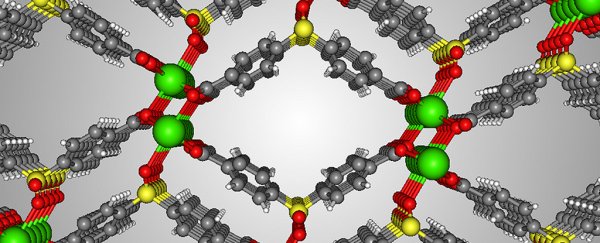All energy-making processes end up taking a toll of some kind on the environment, but the impact is considerably harder to manage with nuclear power, which generates dangerous and long-lived radioactive waste. Now scientists have come up with a new material that could make nuclear fuel recycling cleaner, cheaper, and more effecient.
The new material has been identified through a combination of experiments and computer modelling, and is based on what we already know about materials called metal-organic frameworks (or MOFs).
MOFs have tiny pores inside, often just one molecule in size, which enable them to separate and trap gaseous mixtures by selective adsorption. In the case of nuclear fuel recycling, we're talking about the radioactive gases xenon and krypton, which are given off as waste when uranium and plutonium are repurposed.
Ordinarily, capturing these gases to recycle them requires cryogenic temperatures far below freezing, and that's both expensive and energy-intensive to maintain. The appeal of a MOF material is it could do the same job at an ambient temperature.
A team of computational chemists worked through 125,000 possible MOFs using seven different characteristics to predict how each one would fare at trapping xenon. The simulations ended up identifying a material called SBMOF-1 as a strong contender for trapping the gas effectively, so they put it through its paces in lab experiments to further test its suitability.
"This is a great example of computer-inspired material discovery," said materials scientist Praveen Thallapally from the US Department of Energy's Pacific Northwest National Laboratory. "Usually the experimental results are more realistic than computational ones. This time, the computer modelling showed us something the experiments weren't telling us."
It wasn't all smooth sailing though: the team initially heated up the SBMOF-1 to too high a temperature during preparations, which had the effect of closing up the pores in the material so the xenon molecules could no longer fit inside. Once this temperature was reduced, SBMOF-1 performed effectively in both dry and humid conditions.
Also crucial to the discovery was the application of advanced machine learning techniques, which helped cut down the time required to model each of the 125,000 simulated materials. These extra coding innovations were able to flag unsuitable materials more quickly – otherwise the process could've taken a supercomputer several weeks to complete.
Further study will be required before SBMOF-1 can be cleared for duty and actively used to recycle nuclear fuels, but the research team thinks that this material and other MOFs like it could have further applications in capturing other noble gases (those elements on the far right of the periodic table).
Nuclear fuel recycling is not an idea that every country subscribes to: fears over safety and cost mean the US doesn't currently recycle its nuclear waste, though there are recycling plants in the UK, France, Japan, Russia, and India.
But if discoveries like the one that led to SBMOF-1 can help make the process cheaper and more reliable, it's likely to become a more popular option for countries generating nuclear power in the future.
The findings have been published in Nature Communications.
